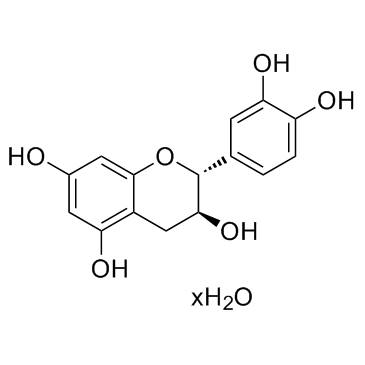(+)-Catechin hydrate

(+)-Catechin hydrate structure
|
Common Name | (+)-Catechin hydrate | ||
|---|---|---|---|---|
| CAS Number | 225937-10-0 | Molecular Weight | 308.283 | |
| Density | N/A | Boiling Point | 630.4ºC at760mmHg | |
| Molecular Formula | C15H14O6.xH2O | Melting Point | 175-177ºC | |
| MSDS | Chinese USA | Flash Point | 335ºC | |
| Symbol |

GHS07 |
Signal Word | Warning | |
|
Chemical genetics reveals a complex functional ground state of neural stem cells.
Nat. Chem. Biol. 3(5) , 268-273, (2007) The identification of self-renewing and multipotent neural stem cells (NSCs) in the mammalian brain holds promise for the treatment of neurological diseases and has yielded new insight into brain cancer. However, the complete repertoire of signaling pathways ... |
|
|
Exogenous acetaldehyde as a tool for modulating wine color and astringency during fermentation.
Food Chem. 177 , 17-22, (2015) Wine tannins undergo modifications during fermentation and storage that can decrease their perceived astringency and increase color stability. Acetaldehyde acts as a bridging compound to form modified tannins and polymeric pigments that are less likely to for... |
|
|
Retaining Oxidative Stability of Emulsified Foods by Novel Nonmigratory Polyphenol Coated Active Packaging.
J. Agric. Food Chem. 64 , 5574-82, (2016) Oxidation causes lipid rancidity, discoloration, and nutrient degradation that decrease shelf life of packaged foods. Synthetic additives are effective oxidation inhibitors, but are undesirable to consumers who prefer "clean" label products. The aim of this s... |
|
|
Harvest date affects aronia juice polyphenols, sugars, and antioxidant activity, but not anthocyanin stability.
Food Chem. 187 , 189-96, (2015) The goal of this work was to characterize how the date of harvest of 'Viking' aronia berry impacts juice pigmentation, sugars, and antioxidant activity. Aronia juice anthocyanins doubled at the fifth week of the harvest, and then decreased. Juice hydroxycinna... |
|
|
Phenolic composition and antioxidant capacity of pomaces from four grape varieties (Vitis vinifera L.).
J. Sci. Food Agric. 95(7) , 1521-7, (2015) Phenolic compounds are widely distributed secondary metabolites in plants usually conferring them with unique taste, flavour and health-promoting properties. In fruits of Vitis vinifera L., phenolic composition is highly dependent on grape variety. Differenti... |
|
|
Dietary supplementation with cocoa flavanols does not alter colon tissue profiles of native flavanols and their microbial metabolites established during habitual dietary exposure in C57BL/6J mice.
J. Agric. Food Chem. 62(46) , 11190-9, (2014) Metabolism of flavanols (catechins, procyanidins) by gut microbiota has been extensively characterized. Comparatively little is known about accumulation of flavanols and their metabolites in the colon tissues, particularly during chronic exposure to low doses... |
|
|
Attenuated Total Reflection Mid-Infrared (ATR-MIR) Spectroscopy and Chemometrics for the Identification and Classification of Commercial Tannins.
Appl. Spectrosc. 69 , 1243-50, (2015) Attenuated total reflection Fourier transform infrared (FT-IR) spectroscopy was used to characterize 40 commercial tannins, including condensed and hydrolyzable chemical classes, provided as powder extracts from suppliers. Spectral data were processed to dete... |
|
|
A novel retinoic acid, catechin hydrate and mustard oil-based emulsion for enhanced cytokine and antibody responses against multiple strains of HIV-1 following mucosal and systemic vaccinations.
Vaccine 29 , 2429-36, (2011) Non-replicating protein- or DNA-based antigens generally require immune-enhancing adjuvants and delivery systems. It has been particularly difficult to raise antibodies against gp120 of HIV-1, which constitutes an important approach in HIV vaccine design. Whi... |
|
|
Antioxidant and protective effect of inulin and catechin grafted inulin against CCl4-induced liver injury.
Int. J. Biol. Macromol. 72 , 1479-84, (2014) In this study, the antioxidant activity and hepatoprotective effect of inulin and catechin grafted inulin (catechin-g-inulin) against carbon tetrachloride (CCl4)-induced acute liver injury were investigated. Results showed that both inulin and catechin-g-inul... |
|
|
Hydroethanolic extract of the inner stem bark of Cedrela odorata has low toxicity and reduces hyperglycemia induced by an overload of sucrose and glucose.
J. Ethnopharmacol. 162 , 352-61, (2015) Cedrela odorata L. (Meliaceae) is a native plant of the Amazon region and its inner stem bark is used in the treatment of diabetes in the form of maceration in Brazilian popular medicine. Until now, there is no scientific study on this activity. The present s... |